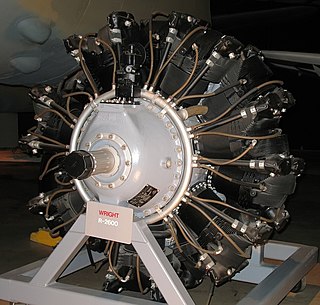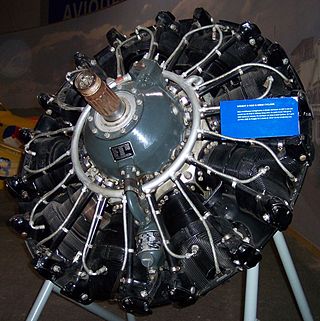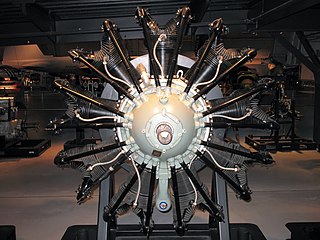Related Research Articles

The radial engine is a reciprocating type internal combustion engine configuration in which the cylinders "radiate" outward from a central crankcase like the spokes of a wheel. It resembles a stylized star when viewed from the front, and is called a "star engine" in some other languages.

The Centaurus was the final development of the Bristol Engine Company's series of sleeve valve radial aircraft engines. The Centaurus is an 18-cylinder, two-row design that eventually delivered over 3,000 hp (2,200 kW). The engine was introduced into service late in the Second World War and was one of the most powerful aircraft piston engines to see service.

The Wright R-3350 Duplex-Cyclone is an American twin-row, supercharged, air-cooled, radial aircraft engine with 18 cylinders displacing nearly 3,350 cubic inches (54.9 L). Power ranged from 2,200 to 3,700 hp, depending on model. Developed before World War II, the R-3350's design required a long time to mature, and was still experiencing problems with reliability when used to power the Boeing B-29 Superfortress.

The Pratt & Whitney R-4360 Wasp Major is an American 28-cylinder four-row radial piston aircraft engine designed and built during World War II. At 4,362.5 cu in (71.5 L), it is the largest-displacement aviation piston engine to be mass-produced in the United States, and at 4,300 hp (3,200 kW) the most powerful. First run in 1944, it was the last of the Pratt & Whitney Wasp family, and the culmination of its maker's piston engine technology.

The Pratt & Whitney R-2800 Double Wasp is an American twin-row, 18-cylinder, air-cooled radial aircraft engine with a displacement of 2,800 cu in (46 L), and is part of the long-lived Wasp family of engines.

The Wright R-2600 Cyclone 14 is an American radial engine developed by Curtiss-Wright and widely used in aircraft in the 1930s and 1940s.

The Wright R-1820 Cyclone 9 is an American radial engine developed by Curtiss-Wright, widely used on aircraft in the 1930s through 1950s. It was produced under license in France as the Hispano-Suiza 9V or Hispano-Wright 9V, and in the Soviet Union as the Shvetsov M-25.

Wright Cyclone was the name given to a family of air-cooled radial piston engines designed by the Wright Aeronautical Corporation and used in numerous American aircraft in the 1930s, 1940s and 1950s.

The Pratt & Whitney Wasp was the civilian name of a family of air-cooled radial piston engines developed in the 1920s, 1930s and 1940s.

The BMW 803 was a German aircraft engine, an attempt by BMW to build a high-output aircraft engine by coupling two BMW 801 engines back-to-back, driving contra-rotating propellers. The result was a 28-cylinder, four-row radial engine, each comprising a multiple-bank in-line engine with two cylinders in each bank, which, due to cooling concerns, were liquid cooled.
The BMW 802 was a large air-cooled radial aircraft engine, built using two rows of nine cylinders to produce what was essentially an 18-cylinder version of the 14-cylinder BMW 801. Although promising at first, development dragged on and the project was eventually cancelled to concentrate on jet engines instead.

The Lycoming XR-7755 was the largest piston aircraft engine ever built in the United States, with 36 cylinders totaling about 7,750 in3 (127 L) of displacement and a power output of 5,000 horsepower (3,700 kilowatts). It was originally intended to be used in the "European bomber" that eventually emerged as the Convair B-36. Only two examples were built before the project was terminated in 1946.

The Curtiss XF14C was an American naval fighter aircraft. It was developed by Curtiss-Wright in response to a request by the United States Navy in 1941 to produce a new shipboard high-performance fighter aircraft.

The Wright R-1300 Cyclone 7 is an American air-cooled seven-cylinder supercharged radial aircraft engine produced by Curtiss-Wright.

The Gnome et Rhône 18L was a French-designed twin-row 18-cylinder air-cooled radial engine. The 18L was a large step up in terms of displacement, power and number of cylinders. The majority of Gnome-Rhone engines were either 7, 9 or 14 cylinders. The engine proved not to be a success, and it was dropped in 1939 due to a poor power-to-weight ratio.

The Shvetsov M-25 was an aircraft radial engine produced in the Soviet Union (USSR) in the 1930s and 1940s, a licensed production variant of the Wright R-1820-F3.

The Shvetsov ASh-21 is a seven-cylinder single-row air-cooled radial aero engine.
The Shvetsov ASh-73 was an 18-cylinder, air-cooled, radial aircraft engine produced between 1947 and 1957 in the Soviet Union. It was primarily used as the powerplant for the Tupolev Tu-4 heavy bomber, an unlicensed, reverse engineered copy of the American Boeing B-29 Superfortress.

The Pratt & Whitney R-1860 Hornet B was a relatively uncommon aircraft engine. It was a development of Pratt & Whitney's earlier R-1690 Hornet and was basically similar, but enlarged in capacity from 1,690 to 1,860 cubic inches (30.5 L). Cylinder bore was increased by 1/8" and the crankshaft stroke by 3/8". Both engines were air-cooled radial engines, with a single row of nine cylinders.
The Hitachi Ha-51, was a Japanese air-cooled twenty-two-cylinder twin-row radial aircraft engine designed by Hitachi during the final years of World War II. The first prototype ran in 1944 at a rating of 1,772 kW (2,000 hp), but only four examples were built. In August 1945, development was halted. The engine had yet to find an application and bombing had destroyed the factory where production was to take place.
References
- 1 2 3 4 5 6 7 Pearce, William (22 March 2013). "Wright Aeronautical R-4090 Cyclone 22". oldmachinepress.wordpress.com. Retrieved 24 September 2015.
- ↑ "Curtiss-Wright XR-4090 A 22-Cylinder Radial". enginehistory.org. Retrieved 24 September 2015.